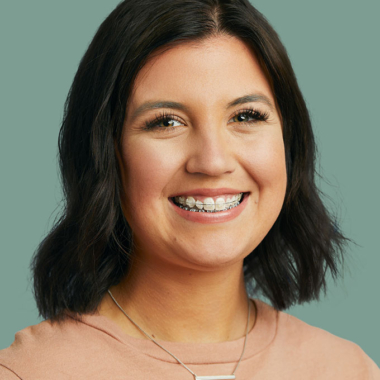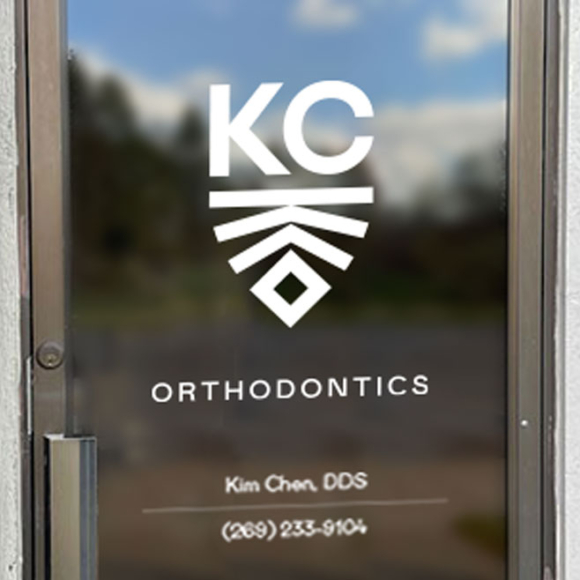Orthodontic Braces for All Ages
We treat every smile with a customized plan using traditional metal or ceramic (clear) braces to ensure you’re getting the best possible orthodontic treatment for beautiful results you’re proud to share. Learn more when you schedule your FREE consultation today with Dr. Chen in Plainwell.


Traditional Metal Braces
Metal braces are the most common type and have been used to straighten teeth for centuries. Made of high-grade stainless steel and combined with elastic ties or bands to gently move teeth as prescribed, traditional metal braces can help create your ideal smile.
Best of all, KC Orthodontics can start your traditional metal braces treatment the same day you come in!

Ceramic Braces
Also known as “clear braces,” ceramic braces function in much the same way as traditional metal braces, but they’re far less noticeable. Just as with traditional metal braces, ceramic brackets gradually realign your teeth to help transform your smile.
Let us help you decide during your free consultation.
Braces FAQs
What foods should I avoid while I have braces?
There is only a small list of foods to avoid while wearing braces. This is to prevent damaging the brackets or to keep food particles from becoming trapped between the brackets and wires. Yes, you can still eat foods like mac and cheese with braces! Foods to avoid include:
- Chewy foods such as fruit leathers, beef jerky, or bagels
- Highly crunchy foods like raw carrots, chips, raw celery, and popcorn
- Sticky foods like caramel candy, licorice, and marshmallows
- Very hard foods like hard candy, hard breadsticks, or pizza crust
- Any food you have to bite into, such as apples or corn on the cob (You can still enjoy these foods by slicing the apples or removing the corn from the cob!)
How do I brush my teeth with braces?
- Before brushing, do a quick rinse with water. This will dislodge any food particles stuck between the wires or brackets.
- Brush beginning at the gum line, using a 45-degree angle of approach. As you move towards the brackets, brush from both the top and the bottom, ensuring that the bristles reach under the wires and around the brackets. This process may take some extra time in the beginning, but once you are used to it, it will be routine for you.
- Follow up with thorough flossing. You will need to use precise and careful flossing techniques to make sure you do not dislodge or loosen the brackets or wires. Dr. Chen will help you nail your flossing technique during your appointment. during your appointment.
Are braces painful? How do I ease the pain?
Generally, braces are not painful. However, you may feel a little sore or uncomfortable immediately after you first get them. This soreness is normal, and it will not last long.
A saltwater rinse can help relieve soreness and inflammation. Dissolve a single teaspoon of salt in a full cup of lukewarm water and swish around your mouth for a few minutes. If soreness persists, you can take an over-the-counter pain reliever such as ibuprofen or acetaminophen. If you experience lip, cheek, or tongue irritation in the weeks after getting braces, some dental wax can quickly and easily alleviate the problem.
I’ve heard of Temporary Anchorage Devices (TADs). What are they, and will I need them?
With severe bite problems and/or patients with missing teeth, orthodontists used to struggle with needing external anchor points to precisely control the adjustment of out-of-place teeth. The solution was using unfortunate-looking and inconvenient appliances like headgear and external braces.
That is, until Temporary Anchorage Devices or TADs came along. Using an anchor attached to the jawbone, TADs eliminate the need for headgear and other uncomfortable treatments by providing an extra anchor point inside the mouth. They’re a safe and effective way to provide more exact orthodontic treatment for patients who need it—and not everyone does. Dr. Chen will know whether TADs are right for you and can advise you about them during your consultation.
How long will I have to have braces?
Most patients will complete braces treatment in 12 to 24 months. It varies by individual, however, because each smile is unique. When you begin treatment, Dr. Chen can give you a good estimate of how long you’ll wear braces.
Then, a few months into your treatment, we’ll have an even better idea of how things are progressing. At that point, Dr. Chen will give you an even better estimate of how much time is left in your treatment.
Can I get braces that are less noticeable?
The most popular option for less noticeable orthodontic treatment is clear Invisalign® aligners. Comfortable and discreet, clear aligners are an effective way to treat complex cases for teens and adults. The best part? They are covered by most insurance plans and the overall cost is comparable to traditional braces!
How much do braces cost near Grand Rapids?
The cost of braces depends on which type of braces you choose, how long you will need treatment, and other factors unique to your smile. We accept most insurance and offer payment plans to help make your orthodontic treatment as affordable as possible. Our orthodontic clinic is located in Plainwell, MI right off of US-131 S.
Visit Your Local Plainwell Orthodontist
From our convenient location in Plainwell, we’re proud to serve the surrounding communities of Otsego, Battle Creek, Allegan, Grand Rapids, and Kalamazoo, MI.


